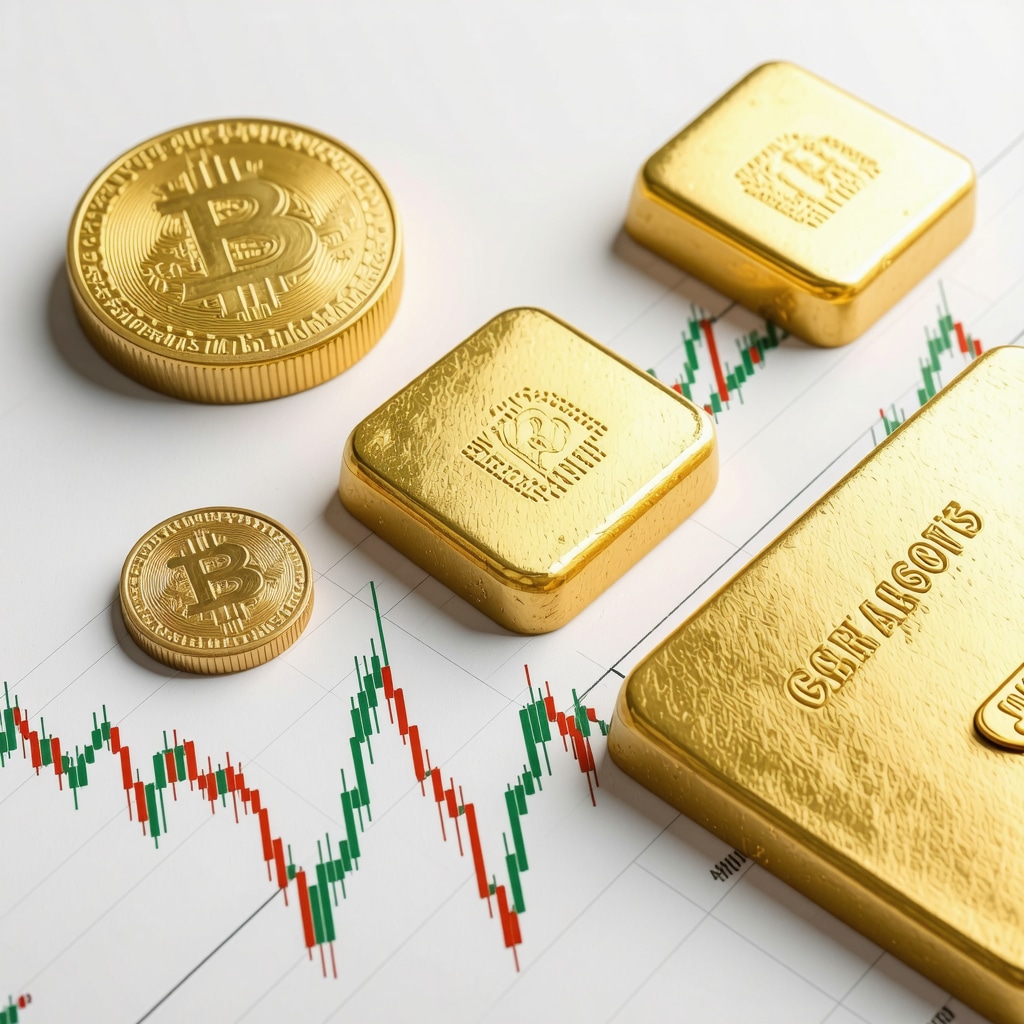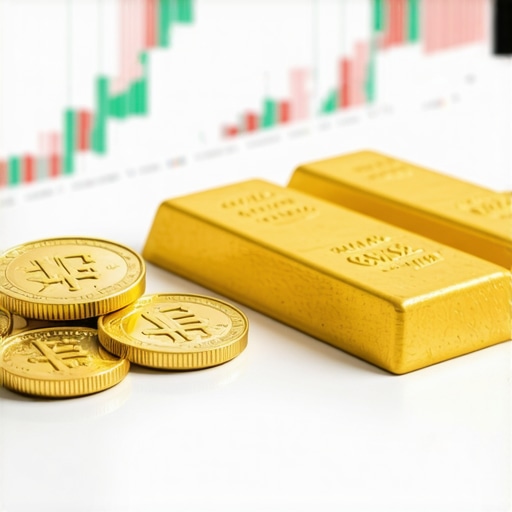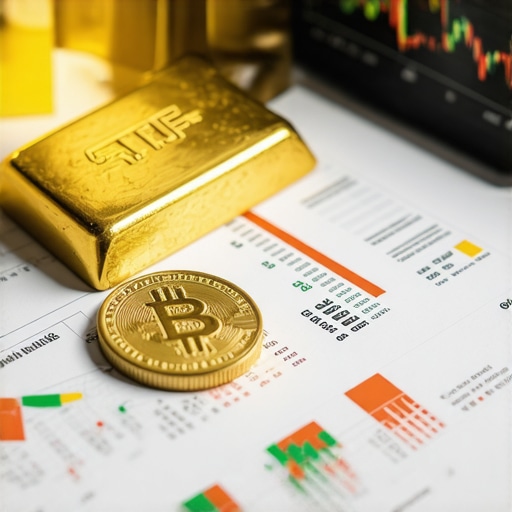My Journey into Gold Investments: A Personal Perspective
It all started a few years ago when I decided to diversify my investment portfolio. I was intrigued by gold because of its historical reputation as a safe haven during economic uncertainties. I remember visiting a local dealer and feeling the excitement of holding my first gold coin. That experience sparked my curiosity about the different ways to invest in gold and how each method might fit into my financial goals.
Discovering the Different Types of Gold Investments
As I delved deeper, I learned about the main types of gold investments: coins, bars, and stocks. Each has its unique appeal and challenges. Coins, especially collectible ones, have a tangible charm and often come with premiums for their rarity and authenticity. Bars, on the other hand, are favored for their straightforwardness and lower premiums, making them a practical choice for bulk holdings. Then there are gold stocks and ETFs, offering exposure to gold without physical storage worries — a modern twist that suits my busy lifestyle.
The Pros and Cons of Gold Coins: My Personal Take
Gold coins have always fascinated me because of their historical and cultural significance. They’re easy to store and carry, and their value is backed by government mints, which adds a layer of trust. However, I found that premiums can sometimes be high, especially for rare or collectible coins, which can eat into profits if not bought carefully. I recommend verifying authenticity through reputable sources like this guide.
Bars: The Practical Choice for Bulk Gold
I personally appreciate gold bars for their simplicity and cost-effectiveness. When I purchased my first gold bar, I appreciated the lower premiums compared to coins. They’re ideal for those looking to accumulate large quantities of gold. The key is to buy from trusted dealers and ensure they’re properly insured and securely stored. I’ve found that understanding the top tips for buying gold bars can make a big difference in making a safe purchase.
Investing in Gold Stocks and ETFs: A Modern Approach
While I enjoy holding physical gold, I also ventured into gold stocks and ETFs. These financial instruments offer liquidity and ease of trading, which is appealing during volatile markets. They also provide exposure to gold mining companies, which can sometimes outperform physical gold. However, I learned that stocks come with company-specific risks, so diversifying is essential. For a comprehensive understanding, I checked out this article on balancing stocks and physical gold.
What Should I Consider Before Investing in Gold?
This is a question I often ask myself. Factors like market trends, geopolitical stability, and personal risk tolerance play crucial roles. I also keep an eye on gold price forecasts to guide my decisions. Ultimately, I see gold as a component of a diversified portfolio, not the sole strategy.
If you’re thinking about investing in gold, I encourage you to start small, do thorough research, and choose trusted dealers. Feel free to share your experiences or ask questions in the comments — I love hearing about others’ journeys into gold investing!
What Are the Hidden Factors That Influence Gold Prices?
As an experienced investor, I constantly analyze the subtle forces shaping the gold market. Beyond supply and demand, geopolitical tensions, currency fluctuations, and central bank policies profoundly impact gold prices. For instance, when major economies face uncertainty, gold often becomes a preferred safe haven, driving prices upward. Keep an eye on this forecast to stay ahead of emerging trends.
How Can Diversification Amplify Your Gold Portfolio’s Resilience?
Diversification remains a cornerstone of robust investment strategies. Combining physical gold, ETFs, and mining stocks can hedge against different risks. For example, while physical gold provides security, mining stocks can outperform in bullish markets but come with operational risks. Balancing these assets helps mitigate volatility and enhances long-term growth. To craft a resilient portfolio, consider insights from this guide.
Are You Overlooking the Impact of Technological Advances on Gold Demand?
Technological innovations, such as increased use of gold in electronics and renewable energy, are expanding industrial demand. This shift can influence supply dynamics and prices. For instance, breakthroughs in miniaturized electronics have heightened gold’s appeal, potentially boosting demand in the coming years. Understanding these trends is essential for savvy investors aiming to anticipate market movements.
Have You Considered the Best Storage Solutions for Your Gold Holdings?
Security and insurance are critical when holding physical gold. Whether you opt for insured vaults or high-quality home safes, each approach has trade-offs. Trusted storage not only protects your assets but also preserves their authenticity and resale value. To explore optimal storage options, review this comprehensive guide.
What Practical Steps Can You Take Today to Maximize Your Gold Returns?
Practical action involves continuous education, timely trading, and diligent research. Utilizing technical analysis and staying updated on global economic indicators can help you identify optimal entry and exit points. Remember, patience and discipline are vital. If you’re eager to refine your approach, check out these expert tips for maximizing profits.
Curious about how to integrate gold seamlessly into your broader wealth strategy? Share your thoughts or experience in the comments — your insights can help others navigate their gold investment journey more confidently!
Personal Reflections on Mastering Gold Investment Strategies
Over the years, my journey into gold investing has been a blend of meticulous research, strategic experimentation, and a constant quest for deeper understanding. I’ve come to realize that the key to long-term success isn’t just in buying gold but in mastering the nuanced strategies that adapt to shifting market dynamics. For instance, integrating technical analysis with macroeconomic indicators has significantly improved my timing for buying and selling, especially during volatile periods. I remember a particular instance when a subtle shift in gold’s price pattern alerted me to an impending rally, saving me from potential losses. Exploring this resource helped me refine my approach, emphasizing the importance of understanding underlying market drivers.
Applying Advanced Tactics for Consistent Profitability
One strategy I highly recommend is leveraging effective trading techniques that focus on market timing and risk management. Techniques like swing trading, combined with a keen eye on economic indicators such as inflation rates and currency fluctuations, can yield consistent gains even amidst market upheavals. I’ve also found that diversifying across physical gold, ETFs, and mining stocks creates a resilient portfolio that can weather various economic scenarios. For example, during the recent inflation surge, my holdings in gold ETFs responded swiftly, offering liquidity and stability. To deepen your grasp, consider exploring this comprehensive guide which covers the latest techniques in smart gold trading.
How Do Central Bank Policies Shape Your Investment Outlook?
From my experience, central bank activities are a significant yet often overlooked factor influencing gold prices. Their gold purchasing patterns, interest rate policies, and monetary easing measures can create ripple effects that impact the entire market. I’ve closely monitored central bank moves to anticipate short-term price movements and adjust my strategies accordingly. Understanding these macroeconomic signals elevates one’s ability to make informed decisions, especially when combined with technical insights. I encourage fellow investors to develop an awareness of geopolitical events and policy shifts, which often act as catalysts for swift market reactions.
What’s Next in Gold Investment for 2026 and Beyond?
Looking ahead, I believe that technological advancements and changing industrial demands will continue to influence gold’s supply and demand. The rising use of gold in electronics and renewable energy sectors suggests that industrial demand may outpace traditional jewelry consumption, potentially supporting higher prices. Staying ahead requires continuous learning and adaptation. I highly recommend keeping an eye on emerging trends and forecasts to align your portfolio with future market realities. Remember, successful gold investing isn’t just about timing but also about understanding the broader economic landscape and your personal risk tolerance.
What Practical Steps Can You Take Now to Maximize Your Gold Investment Returns?
Start by conducting thorough research and setting clear investment goals. Diversify your holdings wisely, balancing physical gold, ETFs, and stocks based on your risk appetite. Use technical analysis tools to identify favorable entry and exit points, and stay informed about macroeconomic developments. Regularly reviewing and adjusting your portfolio ensures resilience against unforeseen market shocks. If you’re eager to deepen your strategic approach, check out these expert tips. Sharing your experiences or questions in the comments can also foster a community of knowledgeable investors, helping everyone grow collectively in this dynamic market.
Deciphering the Complex Interplay of Geopolitical Risks and Central Bank Policies
One of the most compelling aspects of my investment journey has been understanding how geopolitical risks and central bank maneuvers intricately influence gold prices. During periods of heightened global tensions, such as trade conflicts or regional conflicts, gold often becomes a refuge, driving prices upward. Simultaneously, central banks’ gold reserve policies—whether they are accumulating or divesting—can signal underlying economic shifts. My analysis of recent data from the market reports reveals that central banks’ net gold purchases are a strong indicator of future price trends, especially when aligned with macroeconomic indicators like inflation and currency stability.
Leveraging Cutting-Edge Technical Analysis Techniques for Market Timing
Beyond fundamental factors, I’ve integrated sophisticated technical analysis tools to refine my timing. Techniques such as Fibonacci retracements, Elliott Wave analysis, and volume trend assessments have become vital in my strategic toolkit. For instance, during the recent volatility, recognizing a classical head-and-shoulders pattern helped me anticipate a bullish reversal, allowing me to optimize entry points. This nuanced approach is detailed comprehensively in this resource. Combining these methods with macroeconomic insights creates a resilient strategy adaptable to rapid market changes.
How Can Industrial Demand and Technological Innovation Sustain Long-Term Growth?
The industrial sector’s demand for gold, driven by advancements in electronics, renewable energy, and medical technology, is transforming traditional supply-demand dynamics. My research indicates that innovations like ultra-miniaturized electronics and increased use of gold in solar panels are expanding industrial appetite. According to industry trend analyses, these factors could support higher prices well into the next decade. Understanding these shifts enables investors to position themselves strategically, focusing on sectors poised for growth while managing supply constraints.
What Are the Most Effective Ways to Integrate Gold and Mining Stocks for Portfolio Resilience?
Integrating physical gold with mining stocks offers a compelling approach to diversification. While physical gold provides stability and a hedge against currency devaluation, mining stocks can outperform during bullish cycles but carry operational risks. My experience shows that a balanced allocation, guided by thorough stock analysis—assessing factors like reserve quality, management efficiency, and geopolitical exposure—can enhance overall portfolio resilience. For an in-depth methodology, I recommend exploring this guide. Combining these assets allows for both risk mitigation and growth potential, especially in volatile economic environments.
If you’re serious about elevating your gold investment strategy, I invite you to share your insights or questions. Engaging with a community of seasoned investors can reveal nuanced perspectives and innovative tactics that might otherwise be overlooked.
Anticipating Future Trends: The Impact of Digital Innovations and Market Integration
The future of gold investment is increasingly intertwined with technological progress, including blockchain applications for secure transactions and digital gold certificates. These innovations promise greater liquidity and transparency, appealing to a new generation of investors. Moreover, global market integration—through platforms like comprehensive ETF and mutual fund options—facilitates diversified exposure and risk management. Staying ahead involves not only monitoring macroeconomic indicators but also embracing digital transformation trends that reshape how gold is bought, stored, and traded.
Refining Your Approach: Practical Steps for 2026 and Beyond
To maximize your profits, I recommend adopting a multi-layered approach: diversify across physical gold, ETFs, and mining stocks; utilize advanced technical analysis; stay informed about geopolitical developments; and leverage new technologies. Regular portfolio reviews—adjusted for market shifts—are crucial. For practical guidance, I find this resource invaluable. Remember, the key lies in continuous learning and adaptability, integrating both high-level analysis and practical execution. Your active engagement and willingness to evolve will distinguish successful investors in the complex landscape of gold markets.
Things I Wish I Knew Earlier (or You Might Find Surprising)
1. The Power of Patience
In my early days of gold investing, I underestimated how patience could significantly affect returns. Watching the market’s fluctuations taught me that sometimes, waiting for the right moment yields better profits than rushing in. I remember holding onto my gold during a dip, convinced that prices would rebound, and I was right—timing is everything.
2. The Hidden Costs Matter
Many newcomers overlook premiums, storage fees, and transaction costs. These small details add up and can impact your overall gains. I learned to scrutinize dealer fees and storage options carefully, ensuring I chose trustworthy providers like those discussed in this guide.
3. Diversification Is Key
Relying solely on physical gold isn’t enough. I found that combining gold stocks and ETFs helped me manage risks better, especially during volatile periods. This approach, outlined in this article, has been a game-changer for my portfolio.
4. Trends Are Not Always What They Seem
Market hype can mislead investors. I learned to analyze underlying factors like central bank policies and industrial demand, which often tell a different story than headlines. Staying informed through trusted sources helps me make smarter decisions.
5. Emotional Discipline Is Crucial
Gold markets can be emotional rollercoasters. I experienced panic selling during downturns before realizing the importance of staying calm and sticking to my plan. Developing emotional discipline has been essential for consistent success.
6. Technology Is Changing the Game
From digital gold certificates to blockchain transactions, tech innovations are making gold investing more accessible and transparent. I encourage exploring these new tools to stay ahead, as discussed in this resource.
Resources I’ve Come to Trust Over Time
- Kitco: A reliable source for real-time gold prices and market analysis, helping me stay updated with macroeconomic trends.
- Bloomberg: Offers in-depth financial news, including central bank moves and geopolitical events that influence gold prices.
- World Gold Council: Provides industry reports and demand analysis, giving a comprehensive view of supply and demand dynamics.
- Investopedia: Great for understanding complex investment concepts in a digestible way, perfect for beginners like me.
Parting Thoughts from My Perspective
Reflecting on my gold investment journey, I realize that understanding the hidden truths and leveraging trusted resources can dramatically improve your success. Gold remains a valuable part of a diversified portfolio, especially when approached with patience, discipline, and an openness to new technology. If this resonates with you, I’d love to hear your thoughts or experiences. Feel free to share and connect—our collective insights make all the difference in navigating this fascinating market.











Reading through this personal journey into gold investing really resonated with me, especially the part about the importance of patience and understanding market nuances. I started my own gold investment path a couple of years ago, initially simply buying physical gold for security. Over time, I’ve explored ETFs and mining stocks, which has added a new dimension to my portfolio. What’s been interesting for me is how geopolitical tensions and monetary policies directly influence gold prices, something I keep a close eye on through resources like Bloomberg and the World Gold Council. One challenge I faced was understanding when to switch between physical gold and more liquid assets like ETFs during market volatility. For those starting out, do you find a particular approach helps more with timing or balancing your portfolio? I believe ongoing education and staying aware of technological evolutions, like digital gold, are essential for adapting in this always-evolving space.